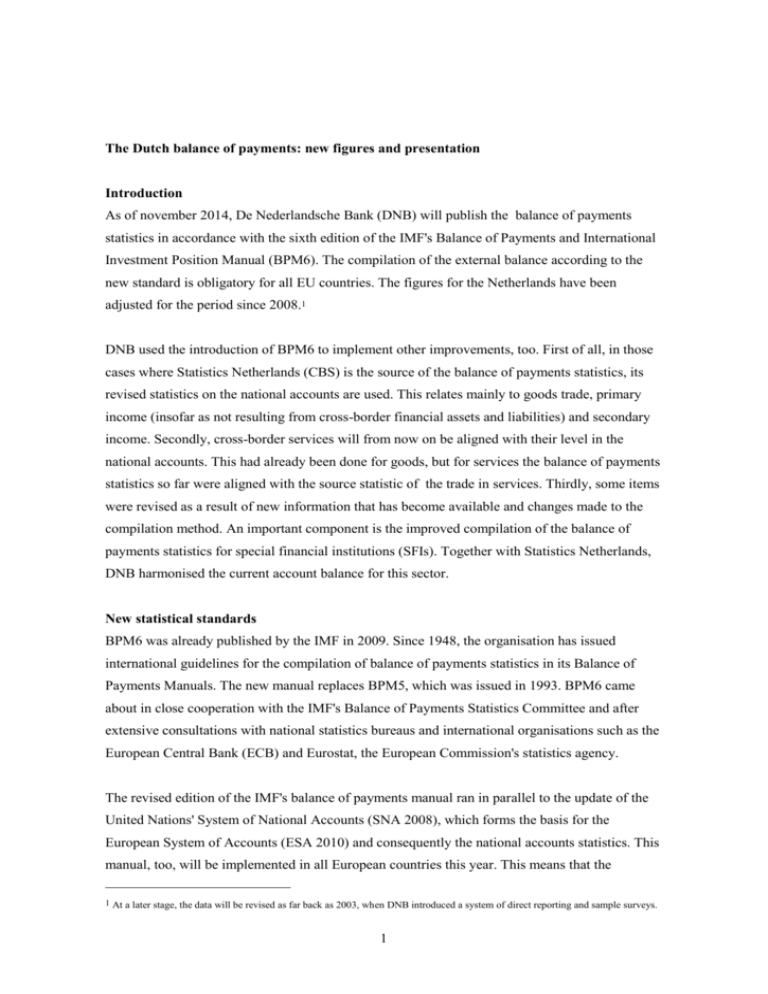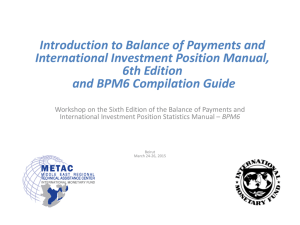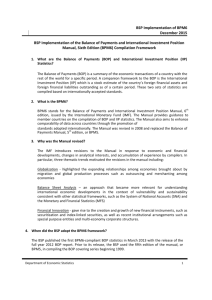The Dutch balance of payments: new figures and presentation
advertisement

The Dutch balance of payments: new figures and presentation Introduction As of november 2014, De Nederlandsche Bank (DNB) will publish the balance of payments statistics in accordance with the sixth edition of the IMF's Balance of Payments and International Investment Position Manual (BPM6). The compilation of the external balance according to the new standard is obligatory for all EU countries. The figures for the Netherlands have been adjusted for the period since 2008.1 DNB used the introduction of BPM6 to implement other improvements, too. First of all, in those cases where Statistics Netherlands (CBS) is the source of the balance of payments statistics, its revised statistics on the national accounts are used. This relates mainly to goods trade, primary income (insofar as not resulting from cross-border financial assets and liabilities) and secondary income. Secondly, cross-border services will from now on be aligned with their level in the national accounts. This had already been done for goods, but for services the balance of payments statistics so far were aligned with the source statistic of the trade in services. Thirdly, some items were revised as a result of new information that has become available and changes made to the compilation method. An important component is the improved compilation of the balance of payments statistics for special financial institutions (SFIs). Together with Statistics Netherlands, DNB harmonised the current account balance for this sector. New statistical standards BPM6 was already published by the IMF in 2009. Since 1948, the organisation has issued international guidelines for the compilation of balance of payments statistics in its Balance of Payments Manuals. The new manual replaces BPM5, which was issued in 1993. BPM6 came about in close cooperation with the IMF's Balance of Payments Statistics Committee and after extensive consultations with national statistics bureaus and international organisations such as the European Central Bank (ECB) and Eurostat, the European Commission's statistics agency. The revised edition of the IMF's balance of payments manual ran in parallel to the update of the United Nations' System of National Accounts (SNA 2008), which forms the basis for the European System of Accounts (ESA 2010) and consequently the national accounts statistics. This manual, too, will be implemented in all European countries this year. This means that the 1 At a later stage, the data will be revised as far back as 2003, when DNB introduced a system of direct reporting and sample surveys. 1 guidelines for the balance of payments and national accounts are now fully aligned methodologically. The presentation of the balance of payments will keep its specific functional categorisation, such as direct and portfolio investment. The ECB and Eurostat prepared the change-over to BPM6 within the European Union in unison. These institutions share the responsibility for the compilation and publication of the external accounts for the euro area and the EU and have amended relevant legislation – guidelines of the ECB and regulations of the European Commission. The legislative amendments primarily reflect the methodological changes introduced in BPM6, but also require a greater level of detail for reporting positions and transactions to the ECB and Eurostat on a quarterly basis. DNB also publishes this greater level of detail. Background to the revisions The revisions presented in BPM6 are largely motivated by economic developments witnessed since the previous edition saw the light in 1993. Globalisation has since spread further and has brought with it an increasing use of cross-border production processes, more complex international corporate structures and larger cross-border flows of labour and capital. Also, increased attention is paid to cross-border claims and liabilities, which are reflected in the international investment position (IIP). Lastly, financial innovation has brought about new and more complex financial instruments, which must also be adequately accounted for in the statistics2. Presentational changes BPM6 impacts presentation in several ways. One consequence is that, unless stated otherwise, balance of payments tables from now on present figures which also include transactions and positions of Dutch SFIs. In addition, the current account now makes reference to, besides the goods account and the services account, the primary income account (the former income account) and the secondary income account (formerly current transfers). This amendment is not just a change in nomenclature. Existing balance of payments items have been reclassified and new items added. For example, taxes on production and imports, and subsidies have been reclassified from the secondary to the primary income account. Retained and reinvested earnings from 2 Appendix 8 of BPM6 gives an overview of all methodological changes compared with BPM5. The FAQs on the introduction of BPM6, prepared by the ECB, also provide useful guidance (see http://www.ecb.europa.eu/stats/external/bpm6/html/BPM6-faqECB.pdf?dad2e270978bb6eb8393bbefd94c7dc7). 2 investments in investment funds were already recorded in the national accounts and will now also be accounted for in the balance of payments, as part of primary income. A number of changes have been made to the classification of sectors and some financial assets and liabilities in the financial account. Reference is now made to the central bank, rather than to monetary authorities, and the former BPM5 sector ‘other sectors’ has now been broken down into ‘other financial sector’, ‘non-financial corporations’ and ‘households and non-profit institutions serving households’ in BPM6. These nomenclature and classification changes have brought BPM6 almost completely in line with national accounts. BPM6 introduces a new sign convention in the financial account, under which both increases in financial assets and increases in financial liabilities are presented with a positive sign. Reductions in financial assets and financial liabilities are presented with a negative sign. The new presentation ensures that financial transactions in the balance of payments and those in the IIP share the same sign. This was not the case in the balance of payments presented under BPM5, in which increases in financial assets used to be presented with a negative sign and reductions with a positive sign. In short, transactions in financial assets have changed sign under BPM6. A further important change to financial account presentation is that foreign direct investment will be presented on a gross basis under BPM6, moving away from the directional principle, which would net out a subsidiary's direct investment in its direct investor (reverse investment) from the latter's direct investment in the subsidiary. Impact on current account balance and net international investment position The size and development of the current account balance do not change substantially over the entire period (see Chart). In accordance with BPM6, the current account surplus for 2013 amounts to EUR 66 billion (11% of GDP). The use of changed and new data sources has adjusted the Netherlands' net international investment position downward by an average of roughly EUR 90 billion (15% of GDP) for the period 2008-2013. At year-end 2013, the Netherlands' net international investment position was EUR 200 billion, representing the balance of EUR 6,634 billion in foreign assets (11 times GDP) and EUR 6,434 billion in foreign liabilities. The increases of several hundreds of billions in the balances, largely caused by the fact that the directional principle is no longer applied, illustrate the Dutch economy's high degree of openness. When direct investment is measured at market value, the net international investment position 3 stands at EUR 388 billion at year-end 2013.3 Impact of BPM6 revision on net external assets (EUR billion) Impact of BPM6 revision on current account surplus (EUR billion) 80 300 70 250 60 200 50 150 40 After revision 30 Before revision After revision 100 Before revision 50 20 0 10 -50 2008 2009 2010 2011 2012 2013 0 2008 2009 2010 2011 2012 -100 2013 Current account and capital account The trade balance and the secondary income account both contribute to an upward adjustment of the current account surplus. Conversely, the primary income account has been structurally adjusted downward. While the trade balance, which aggregates the balances on goods and on services, has only edged up, underlying shifts between goods and services are in the order of some tens of billions per annum. The substantive impact of BPM6 on the capital account is very small. Current account balance after revision (EUR million) Balance on goods Balance on services Primary income balance Secondary income balance Current account balance 2008 59.701 -6.657 -15.469 -11.925 25.651 2009 53.716 -7.420 -2.745 -9.492 34.060 2010 60.229 -7.416 5.439 -10.716 47.536 2011 64.920 -10.017 12.411 -10.510 56.804 2012 68.793 -10.568 17.478 -11.070 64.632 2013 74.569 -8.160 13.604 -14.079 65.935 Revision of current account balance (EUR million) Balance on goods Balance on services Primary income balance Secondary income balance Current account balance 2008 18.136 -15.352 -3.924 -204 -1.343 2009 19.325 -11.275 -4.264 -897 2.889 2010 20.255 -16.478 -2.243 1.185 2.719 2011 21.708 -21.594 -1.223 2.033 924 2012 24.865 -20.854 -657 2.622 5.975 2013 24.413 -23.963 -2.598 989 -1.159 An important change made to the current account is the contribution from SFIs, which has been adjusted downward by some EUR 3 billion. For domestic costs incurred by SFIs in the form of taxes, services and wages, a fixed amount of EUR 1.5 billion had been used to date, based on a once-only and outdated estimate. That fixed amount has now been replaced by an estimate based 3 The method DNB uses to estimate the net international investment position is described in the DNBulletin "The Netherlands richer thanks to better figures”, dated 26 March 2012 (see http://www.dnb.nl/en/news/news-and-archive/dnbulletin-2012/dnb270308.jsp). 4 on more recent source data. In addition, domestic capital income received by SFIs has also been taken into account. This is income which Dutch SFIs receive from domestic non-SFI subsidiaries4 and distribute to their foreign parent companies. The latter capital flow, which had not been included in outward primary income before, amounted to EUR 3.0 billion in 2013. The resulting net contribution from SFIs to the current account is EUR 1.4 billion negative for 2013.5 The primary income balance also fell, on average by over EUR 1 billion, as the negative balance of taxes on production and imports and subsidies has been reclassified from the secondary income account (current transfers) to the primary income account. By contrast, the primary income balance increased due to the fact that the cross-border share of earnings retained by foreign and Dutch investment funds must also be recorded in the balance of payments under BPM6. To date, only distributed earnings had been recorded, but BPM6 prescribes that an investment fund's undistributed earnings must also be allocated to its shareholders. This change affects both the income account (reinvested earnings) and the financial account (reinvestment of earnings). With investments of Dutch residents in foreign investment funds amply outstripping those in the reverse direction, this change has pushed up the primary income balance. Income has increased by around EUR 2 billion per annum, whereas expenditure has gone up by less than EUR 200 million. For recent years, the annual balance on goods has been adjusted upwards by approximately EUR 20 billion. This increase largely results from the classification of goods under merchanting as goods rather than services and the revision of the goods statistics of Statistics Netherlands. Merchanting is defined as the purchase of goods by a resident from a non-resident, combined with the subsequent resale of the same goods to another non-resident without the goods having been present in the compiling economy. Under BPM5, the net margin on this type of trade was included in services, as part of other business services. BPM6 determines that merchanting of goods is classified as goods, with imports being deducted from exports. This revision has resulted in upward adjustments of around EUR 9 billion per year since 2008 for both the exports of goods and the balance on goods, with the balances on the services account falling by comparable 4 Although an SFI's assets are mostly of a foreign nature, an SFI may also have a small percentage in domestic assets. 5 This figure must not be confused with the contribution which the presence of SFIs makes to the Dutch economy. Although capital outflows from the SFIs' subsidiaries to their foreign parent companies run through the SFIs, they would also have occurred without the SFIs' presence. In addition, the Dutch government receives withholding tax from the Dutch SFIs' parent companies on the income they receive from their Dutch SFI subsidiaries. This withholding tax does bear a relationship with the presence of SFIs, but rather than being visible from the SFI sector's figures, it is included in current transfers received by the Government sector. 5 amounts in the same period. The revision of the goods statistics of Statistics Netherlands is due in part to the adjustments implemented by Statistics Netherlands for illegal trade and source alignment6. For 2010 – the new base year for the national accounts – these adjustments contributed EUR 1 billion and EUR 14.5 billion, respectively, to the upward revision of the balance on goods. Conversely, manufacturing services on physical inputs owned by others are no longer classified as goods. This is because the new manuals determine that classification as international trade strictly requires a change of ownership between residents and non-residents, which means that exceptions to this rule will no longer be made. Given that manufacturing services do not involve a change of ownership, the gross trade flows are no longer recorded under goods. Instead, the value added by manufacturing services is included in services. This has resulted in a downward annual adjustment of the balance on goods (and a corresponding upward adjustment of the services balance) of less than EUR 1 billion, with the exception of 2008. Beyond the reclassifications between goods and services, there are also reclassifications within the goods account. Goods procured in ports by carriers will from now on be part of other merchandise. The services account is also impacted by such reclassifications. For example, postal and courier services – previously implicitly included in the former communication services category – are now classified as transport services. Telecommunication services, making out the remaining part of communication services, have been incorporated into computer and information services. Finally, there has also been a reclassification within business services. The downward adjustment of services is due – beyond the reclassifications between goods and services noted earlier – to a lower estimate of the contribution of SFIs, which underwent a downward adjustment of approximately EUR 1 billion per year. This adjustment results from a change in the measurement of SFI exports. In accordance with international agreements, the value of transactions with entities within the same group is calculated as the sum of domestically incurred costs (domestically used goods and services and wages). Previously, the statistics were based on the actual intra-group prices. The strategic decision to align total services according to the balance of payments with the national accounts, in accordance with the current practice for goods, also contributes to a decrease in the recorded balance of services. 6 For more information, please refer to Statistics Netherlands (2014), National Accounts Revision 2010 (in Dutch only). 6 Financial transactions and net international investment position As in the case of the current account, the revision has not resulted in a structural increase or decrease in the balance of all transactions in the financial account. The sometimes considerable adjustments in the various component accounts are the result of improved source information. Net financial account after revision (EUR million) Net direct investment Net portfolio investment Net financial derivatives Net other investment Net reserve assets Net financial account Revision of net financial account (EUR million) Net direct investment Net portfolio investment Net financial derivatives Net other investment Net reserve assets Net financial account 2008 53.679 2009 2010 2011 2012 2013 33.732 58.691 33.510 440 34.930 -66.327 2.941 -39.807 5.432 56.929 22.987 6.033 -28.265 8.967 6.805 -5.997 -2.738 26.444 29.701 14.945 11.919 4.775 8.810 560 4.768 391 1.774 1.991 -56 20.389 42.877 43.187 59.440 58.138 63.932 2008 2009 2010 2011 2012 2013 -8.118 -16.525 -11.798 -5.504 -10.857 3.217 10.939 8.881 -11.755 1.402 13.893 -619 -1 48 -20 -7 140 2.209 -932 6.233 27.709 2.214 5.838 1.244 0 4.705 -0 0 1.888 3.342 4.136 -1.894 - 0 9.015 6.050 DNB has made considerable downward adjustments to the net international investment position. These adjustments are largely on account of the use of new and improved sources for estimating the SFI investment position and improved estimates for foreign securities holdings. In addition, the new observation of foreign securities holdings of Dutch money market funds has resulted in a limited structural increase in the net international investment position (EUR 1 billion). Net external assets after revision (EUR million) Net direct investment Net portfolio investment Net financial derivatives Net other investment Net reserve assets Net external assets Revision of net external assets (EUR million) Net direct investment Net portfolio investment Net financial derivatives Net other investment Net reserve assets Net external assets 2008 2009 2010 2011 2012 2013 448.346 529.371 625.767 658.002 673.003 634.299 -487.492 -500.365 -573.877 -623.599 -584.119 -512.320 38.406 13.229 24.849 69.125 65.525 37.068 -69.591 -64.681 -53.437 -31.397 -31.629 7.752 20.485 27.495 34.649 39.623 41.561 33.639 -49.846 5.048 57.950 111.753 164.341 200.437 2008 2009 2010 2011 2012 2013 44.612 44.558 32.841 27.628 43.255 -471 -43.116 -62.723 -39.515 -47.085 -89.150 -57.997 -1.063 1.326 -423 -31 2.154 -75.091 -73.657 -78.454 -72.777 -64.146 -23.175 1 -0 0 8 29 -90.496 -85.552 -92.235 -110.063 -79.461 -74.657 - So far, the investment positions of SFIs were based on the assumption that the assets and 7 liabilities of SFIs are completely foreign. While this assumption applies to most SFIs, there are some institutions that also have domestic investment relationships. For example, SFIs have equity holdings in Dutch companies and – on a limited scale – investments in Dutch securities. Their assets also include intangible assets, in particular intellectual property rights, which are domestic by definition. Conversely, domestic sectors also invest in securities issued by SFIs. These domestic positions have been estimated using improved sources and deducted from the foreign assets of the SFIs. For recent years, this concerns an amount of more than EUR 35 billion. The balance of direct investment has nevertheless increased, which is on account of another BPM6 change. Intra-group loans between SFIs and banking business units are no longer classified as other financial transactions. That is why assets worth EUR 80 billion have been reclassified each year from other financial transactions to direct investments on average. As regards liabilities, reclassifications have resulted in adjustments of more than EUR 30 billion. The decrease in the net international investment position also has a methodological explanation, which concerns the recording of IMF-issued special drawing rights (SDRs). These SDRs already formed a part of the official reserves. BPM6 now requires that the SDR countervalue – the allocation of the special drawing rights – is also included in the statistics, and more particularly, in other investment. For other investment, this implies an increase in the liabilities of about EUR 5.5 billion from 2009, which is when an allocation revision of almost EUR 4.7 billion took place.7 A change that is unrelated to BPM6 but that also has an effect on the net international investment position concerns the treatment of cash. On the one hand, this regards the difference between the volume of euro banknotes that DNB actually circulates and the part of the total volume of issued euro banknotes allocated to DNB according to an allocation key applied in the Eurosystem. This difference is negative for the Netherlands, which means that DNB has an accounting claim on the other central banks of the Eurosystem. On the other hand, it concerns the difference between the estimated cash holdings of residents and the issue by DNB. This difference is also negative, creating a liability of DNB to non-residents. Both positions must be recorded in other investment. Cash had not yet been included in the statistics due to estimation uncertainty. Now a decision has been made at the European level to include cash, given that this item has become more important 7 By extension, from now on, both the interest received and paid on the special drawing rights must be recorded. However, the effect on the current account is negligible. In addition, BPM6 requires that an allocation of SDRs is credited to the official reserves via a transaction rather than an 'other volume movement' (which explains the EUR 4.7 billion adjustment in the financial account). 8 in recent years and the national accounts already included cash entries. Both entries have a positive net effect of almost EUR 4 billion on the net external assets as at year-end 2013. The final revision in the context of BPM6 concerns the change in the recording of inward and outward transactions within a direct investment relationship, which are no longer netted as a matter of course. Although this does not have an impact on net direct investment, and therefore on the net international investment position, it has a considerable effect on the volume of Dutch direct investment abroad and vice versa. This change has resulted in an average upward adjustment of both Dutch direct investment abroad and foreign direct investment in the Netherlands of almost EUR 400 billion for the entire revision period, mainly concerning SFI investment positions. Links IMF Balance of Payments and International Investment Position Manual – Sixth Edition (BPM6). http://www.imf.org/external/pubs/ft/bop/2007/bopman6.htm ECB Guideline of 9 December 2011 on the statistical reporting requirements of the ECB in the field of external statistics (recast) (ECB/2011/23). http://www.ecb.europa.eu/ecb/legal/1005/1022/html/index.en.html Regulation (EC) No 184/2005 of the European Parliament and of the Council, establishing a common framework for reporting b.o.p., international trade in services and foreign direct investment data. http://eur-lex.europa.eu/LexUriServ/LexUriServ.do?uri=OJ:L:2005:035:0023:0055:EN:PDF Commission Regulation (EU) No 555/2012, amending Regulation (EC) No 184/2005 in line with BPM6. http://eur-lex.europa.eu/LexUriServ/LexUriServ.do?uri=OJ:L:2012:166:0022:0066:EN:PDF 9






